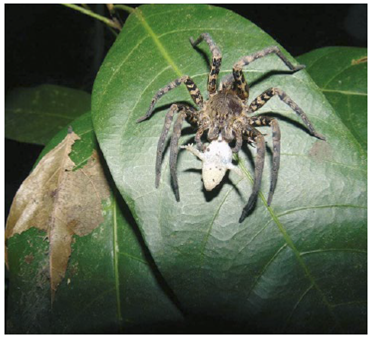Introduction
Small toads are potential prey and constitute an important component in the diet of many predators (Diesel et al., 2014; Rocha et al., 2014); some arthropods as chilopods, crustaceans, insects and arachnids are known to prey upon them with distinct foraging methods (Menin et al., 2005; Barej et al., 2009; Maffei et al., 2010; Moura & Azevedo, 2011; Diesel et al., 2014; Pinto & Costa-Campos et al., 2017).
Among arthropods, spiders are the most important and frequent predators of anurans (Barej et al., 2009; Zaracho, 2012; Foerster et al., 2017; Pinto & Costa-Campos et al., 2017). There exists broad documentation on anurophagy by spiders, with most of the reports being from the Neotropics (Maffei et al., 2010). Nonetheless, the impact of predation on amphibian populations remains unknown (Barej et al., 2009) because most instances of spider attacks on amphibians are based on fortuitous observations of single events (Menin et al., 2005; dos Santos, 2009).
Toledo (2005) found 68 reports of anurans as prey of invertebrates, from which approximately 48 % presented spiders as predators, especially of the families Pisauridae and Ctenidae (Moura & Azevedo, 2011). Ctenidae (Araneae) is composed by large nocturnal hunters (Barej et al., 2009) that abound in neotropical forests (Bhukal et al., 2015). These spiders are considered to be ambush predators (Maffei et al., 2009) because they wait for their prey to be close enough to capture it (Foerster et al., 2017), especially at the edge of water bodies (Bhukal et al., 2015).
Here we report observations that constitute the first record of a predation event carried out by the spider Ancylometes bogotensis (Araneae: Ctenidae) on the frog Elachistocleis panamensis (Anura: Microhylidae) in Montes de María, Sucre, Colombia.
Materials and methods
Study area. Our observation was made in a tropical dry forest fragment in the municipality of Colosó (subregion of Montes de María), department of Sucre, Colombia (9°31’53.555”N-75°20’53.027”W; 178 m a. s. l.).
Methodology. We observed a fortuitous and already started arachnid-amphibian predation case during nocturnal monitoring in the study area. We identified the species in situ following previous knowledge and with support in Höfer & Brescovit (2000). We registered time, temperature and relative humidity using a digital thermo-hygrometer (Max-Min Thermo Hygro & Clock; Brixco®). The description of the predation event was made based on the place of sighting and the behavior of individuals during observation. Lastly, we took a photograph with a digital camera.
Results
An individual of A. bogotensis was observed when it was preying upon an individual of E. panamensis at 21:41 h on November 28th, 2016 during the rainy season (temperature: 27 °C; relative humidity: 82 %).
The predation case was recorded on a leaf of a shrub (≈0.40 m high) that was not identified, near a stream (≈2 m). The spider was holding the anuran with the chelicerae sunk into its low-abdominal region and with the aid of the pedipalps (Figure 1). No distress or agonistic call was heard; the anuran did not attempt to set itself free from the spider and it was paralyzed.
Discussion
The genus Ancylometes (Ctenidae) shows a varied diet that ranges from insects to small vertebrates such as fish, tadpoles, frogs, toads and lizards (Bhukal et al., 2015). Recently, A. bogotensis has been pointed as a predator on the crab Poppiana dentata (Decapoda: Trichodactylidae) (Bhukal et al., 2015), the fish Anablepsoides hartii (Cyprinodontiformes: Rivulidae) (Deacon et al., 2015) and the toad Rhinella beebei (Anura: Bufonidae) (White, 2015).
The observed behavior of nocturnal predation on leaves near bodies of water and the use of chelicerae and pedipalps to hold prey coincide with the published literature on the subject for A. bogotensis, the genus Ancylometes and other members of Ctenidae (Menin et al., 2005; Barej et al., 2009; Santana et al., 2009; Maffei et al., 2010; Moura & Azevedo, 2011; Bhukal et al., 2015; Foerster et al., 2017; Pinto & Costa-Campos et al., 2017).
Also, the paralysis of E. panamensis during the observed predation by A. bogotensis agrees with previous records of predation by species of the Ctenidae family (Maffei et al., 2010; Foerster et al., 2017; Pinto & Costa-Campos et al., 2017); for example, the poison of Ancylometes rufus is known to have a rapid effect, for it may immobilize an individual of Dendropsophus brevifrons in 45 seconds (Pinto & Costa Campos et al., 2017).
Elachistocleis panamensis is a small microhylid with a restricted distribution in central Panamá, the lowlands of the Magdalena River valley and the Caribbean region in Colombia (Blanco-Torres et al., 2015). It is classified in the trophic guild of the insectivorous with nocturnal and terrestrial habits (Blanco-Torres & Renjifo, 2014). This frog is a little-known species, and information on its life history is scarce (Vera-Candioti, 2006; Blanco Torres et al., 2015).
The small size of E. panamensis is relevant for the current predation case because allows the species to be an easy prey of invertebrates (Guerra-Batista et al., 2013; Foerster et al., 2017). Nevertheless, the fossorial behavior along with the remarkably seasonal nature of this frog -it is only found after heavy rains, vocalizing next to water bodies or inundated ponds (Romero, Martínez & Lynch 2012; Blanco-Torres et al., 2015)- suggest that it is probably not a common prey. On the other hand, previous and present data indicate the important role of A. bogotensis as a generalist and opportunistic predator, as pointed out by White (2015).
















